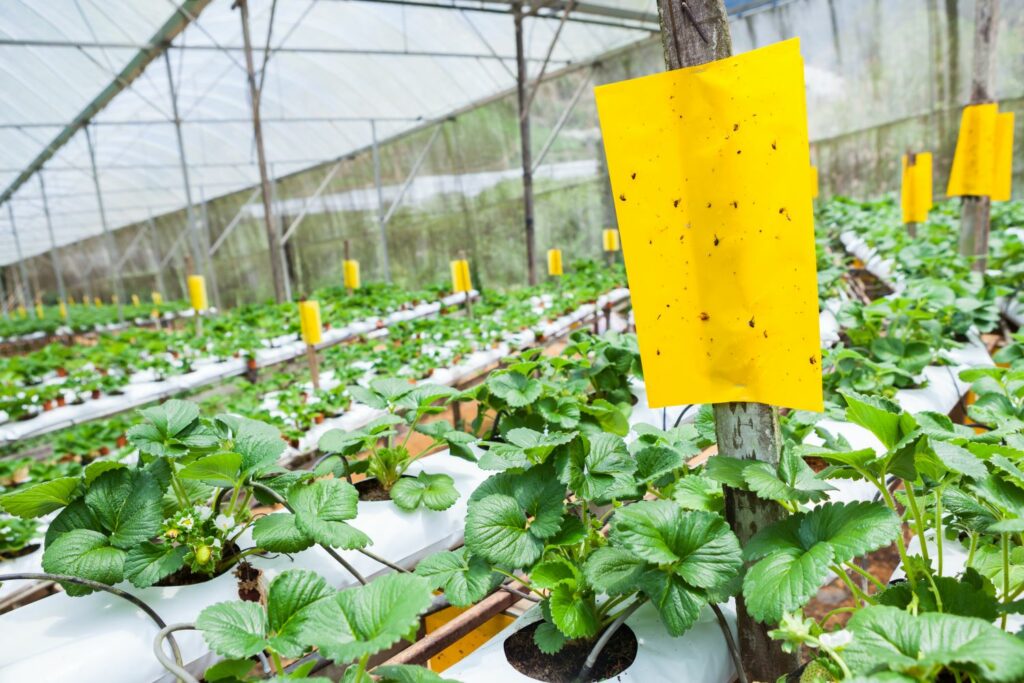Above tabletop traps improve thrip monitoring in strawberry crops
5th December 2022
Contrary to the current grower practice of monitoring pest thrips with below tabletop traps, placing the traps level with or slightly above the strawberry crop significantly improves their effectiveness, sensitivity, and value to growers, NIAB research has shown.

Stock photo for illustration purposes only.
Dr Andrew Gladman, plant scientist and entomologist at ADAS, presented his research on ‘Improved methods for monitoring thrips in strawberry’ at the NIAB Soft Fruit Day technical webinar on 30th November 2022.
According to Dr Gladman’s findings, above tabletop sticky traps not only capture significantly more pest thrips, but also a wider variety of problematic species compared to traps hanging below plant level. This has major implications for strawberry growers, as better monitoring allows for more effective pest control and higher plant productivity.
Western flower thrips (WFTs) have been the predominant pest challenge for strawberry growers in recent years, causing bronzing and scarring of fruit and reduced yield from the affected crop. Despite the industry achieving good overall control of WFTs, growers continue to complain about pest problems in strawberry crops, Dr Gladman said.
Research carried out by ADAS and NIAB has identified a number of dark thrip species that contribute to pest pressure in UK strawberries. These species, namely rubus, rose, onion and flower thrips, cannot be effectively controlled by WFT-focussed integrated pest management (IPM), Dr Gladman noted.
There is substantial evidence that blue sticky traps attract WFTs and using a species-specific aggregation pheromone lure can further increase trap catch. However, considerably less research has been conducted on monitoring and colour attraction in other problem-causing thrip species.
Therefore, Dr Gladman and his team set out to investigate whether combining other commercially available lures with blue sticky traps would improve the monitoring of the more elusive dark thrip species.
Two lures that are both based on plant volatiles were selected for the trials, namely:
- Lurem-TR: attracts WFTs, onion thrips and rubus thrips
- Thripnok: attracts WFTs and onion thrips
Moreover, many growers are currently under the impression that hanging monitoring traps below tabletops increases the likelihood of thrips being caught. However, since there is little high-quality quantitative data on the best placement for sticky traps, the research also looked at whether the location of the traps has an impact on their effectiveness.
Below tabletop traps ineffective in monitoring pest thrips
In the first round of the trial, three treatments were applied to see whether the current thrip monitoring practice can be improved by using either one of the selected lures. Blue sticky traps alone were used as controls, while traps combined with a Lurem-TR or Thripnok lure were also applied.
All traps were hung below crop level and there were 20 replicates of each trap, which were observed for a period of three weeks.
Dr Gladman and his team found no significant differences in the performance of blue sticky traps alone versus traps enhanced with lures. Moreover, all traps captured more WFTs than dark thrip species and thus cannot be used to improve monitoring of the latter.
There was also a large number of cereal thrips captured on both control and enhanced traps. While not harmful to strawberry crops, cereal thrips are very difficult to distinguish from dark thrips and can therefore give a false indication of the number of problematic species captured on traps.
Influence of trap location on thrips catch
The next phase of the trial tested whether the location of the traps alone influences the number of thrips and species captured. Blue sticky traps were hung below the tables as well as attached to a pea stick just above the crops.
No lures were applied on this occasion, and each treatment was replicated five times and spaced at 10m intervals.
Following a three-week period, Dr Gladman and his colleagues counted 8.1-times more pest thrips on above tabletop traps compared to those hanging below. Traps placed above crop level also demonstrated far better sensitivity than those below, capturing five pest species in total versus the three on the latter.
What’s more, over 50% of species on below tabletop traps were incidental cereal thrips, with these representing only 7% of species in traps on the level above.
Lures improve the performance of sticky traps above crop level
In the study’s final phase, Dr Gladman and his team applied four different treatments to investigate whether commercial lures affect the performance of above tabletop traps.
The treatments consisted of:
- Blue sticky traps alone
- Blue sticky traps + Lurem-TR
- Blue sticky traps + Thripnok
- Blue sticky traps + Magipal (natural enemy attractant; considered a thrips repellent).
In this instance, both Lurem-TR and Thripnok significantly increased the capture of pest thrips, namely by 2.8-fold and 1.3-fold, respectively. As a result, they could be a cost-effective way of improving trip monitoring in strawberry crops, depending on the history of thrips at the site, Dr Gladman noted.
The researchers have identified a complex mix of pest species present within strawberry that vary with site and throughout the season. While Lurem-TR did attract a higher number of dark thrips than sticky traps alone, more effective lures may need to be developed to tackle the challenge of monitoring these species in strawberry crops, Dr Gladman concluded.
